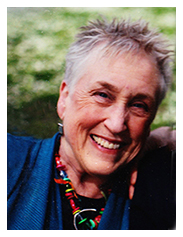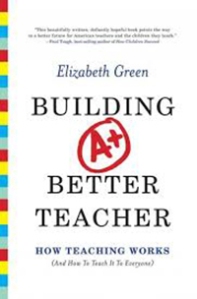 Vicky Kelman
Vicky Kelman
Green, Elizabeth. Building a Better Teacher: How Teaching Works (and How to teach it to Everyone). W.W. Norton and Company. 2014
It sounds like good news when Elizabeth Green first tells us that being a good teacher is not just a random gift but rather is a set of skills that can be learned. That sounds good and reassuring. We want to say, “that’s great. If anyone can learn it, we are in good shape.”. But what becomes clear, is that the acquisition of those skills is hard intellectual work that requires time, dedication, time, patience, time, tolerance for trial and error and an infra-structure that provides all that. The story Green has brought to tell us, a story about learning to teach: “it’s complicated.”
 “Building a Better Teacher,” is an important read for all of us who care about education — and don’t we all? In a way, it is three books in one: the first book tells a remarkable story of some thoughtful, inventive trailblazers in the field of teacher education; the second one concentrates on the Charter School movement and its contributions and challenges; the third one is about the author’s own venture into classroom teaching. I will just talk about “books” one and three. I have chosen to talk about “books” one and three, in this column.
“Building a Better Teacher,” is an important read for all of us who care about education — and don’t we all? In a way, it is three books in one: the first book tells a remarkable story of some thoughtful, inventive trailblazers in the field of teacher education; the second one concentrates on the Charter School movement and its contributions and challenges; the third one is about the author’s own venture into classroom teaching. I will just talk about “books” one and three. I have chosen to talk about “books” one and three, in this column.
TKOT—This Kind of Teaching—a code phrase[1] used by two gifted teacher educators, Deborah Ball and Magdalene Lampert and their cohort of teacher-educators at Michigan State, to describe the kind of teaching they were striving for, for themselves and the teachers they were supervising.
I can describe this best by saying that they were not interested in teaching their students to get the right answers as much as they were in getting their students thinking, engaging, and wrestling with the processes that could take them to the answers. Conjectures, proofs, examples and counter examples, arguments, questions, mistakes and more conjectures were considered the hallmarks of TKOT. Their students were learning to “do math,” to think like mathematicians —-to THINK. Not to replicate formulas and follow set steps.
I was thrilled to encounter these two women in the pages of this fascinating book. They have both had a strong influence on my own journey as a teacher and teacher-educator and on the learning ( direct [ Ball] and indirect [ Lampert ] ) of many teachers in Jewish schools. Deborah has served as a key faculty member of MTEI a national Jewish teacher-educator study program funded by the Mandel Foundation and directed by Gail Dorph ( in which I have participated). Lampert had written a paper[2] whose theme was TKOT, the teaching of kids to think like mathematicians — that several Torah teachers ( Gail Dorph, Joel Grishaver and myself) used as a guideline from which we tried to teach Torah teachers TKOT, in other words, to teach kids to think like Bible scholars and commentators (rather than like right-answer-seekers) . Lampert’s paper became our guidebook one summer as we used it as the basis of an intensive for day school Torah teachers.
“Building a Better Teacher, ” tells the story of how Ball and Lampert , working together at Michigan State, reached their unique approach to teaching, how they both came to be at Michigan State, where , thanks to a third seminal figure ( also someone from whom I have learned a lot) Lee Shulman, they also began to reveal the underpinnings of pedagogical content ( the kind of knowledge one needs to teach which is neither “general education” nor “pure discipline” ) and made Michigan State a powerhouse in the world of teacher education and a place that developed an approach to teaching unlike most other teaching going on anywhere else in the world…
Green weaves an amazing tapestry of the story of the attempt to teach TKOT to teachers. The story involves universities, school systems, teacher education in Japan, professors of mathematics and of education, economists, foundations, and grants….It is a dazzling and inspiring story — but one whose very complexity flies in the face of that last phrase of the three part title of Green’s book, ” and how to teach it to everyone.”
In answer to her initial query as to whether teaching is a gift or a set of skills that can be learned…I think she manages to prove that it can be learned — but not by most teachers in most settings in the United States the way schools are currently set up and the way teachers’ ” work” is currently defined ( including the Jewish schools which most readers of this column are involved in and concerned about).
Replicating the work of Ball and Lampert, incorporating Japanese Lesson Study and other approaches to teacher professional development would require a complete overhaul of the typical teacher’s day so that there is real time devoted to the kind of on-going learning that is the hallmark of TKOT , which would include immersion in subject matter, and co-planning with colleagues followed by observing and critiquing each other. To do this would mean every teacher teaching fewer classes so that there is paid time within the work day for the serious deep work of learning to teach. It would have to become a shared (public) understanding that learning and honing one’s craft is part and parcel of the very definition of “teaching.”
And now for “book” 3: Green herself teaches a classroom of kids ONE LESSON.
A teacher she meets questions her suitability to write about teaching without any experience of being a teacher. She decides to take up his challenge.
She teaches two lessons ….prepares for many days, has studied with Ball and Lampert and Shulman and many others in the pantheon of teacher educators. She knows about Japanese lesson study and the Italian language school approach. She co-plans her lesson with an exceedingly talented and experienced teacher whose class she will be teaching, (AND, her teaching responsibilities do not include attending faculty meetings, dealing with recalcitrant or struggling students, conferencing with parents, leaky pipes, broken toilets, broken copy machines, or any administrative chores.
She judges her results as “OK.” and shares that if she hadn’t worked with the teacher who challenged her and if she hadn’t done all the research necessary for the book – she would have done “dramatically worse.”
How real is this as a scenario for teaching?
Well, if every teacher could prepare for every lesson the way that Green has the opportunity to do, we would have the most amazing teachers and the highest quality education system in the world. So, in a way, she is correct. Anyone ( given all the support and time she had) CAN learn to teach —- the question remains — how do we enact this and make it happen for more teachers in more schools for more students?
It’s not “pie in the sky.” It can be done. It has been done, not just by Green herself, but in single schools here and there, in small pockets (there are MTEI participants who have followed in the TKOT path). Perhaps not across the board, everywhere, but we don’t need to think “all or nothing.” Can we find a school director, a small group of teachers, one school board chair, one teacher, one funder to take the first step, to begin to establish a beach-head, to follow the path set out by Ball and Lampert and described so clearly by Green? Maybe it’s you.
______________________
1 The term TKOT is no longer in use but it seemed a useful phrase to use here in referring to the whole approach to teaching that Green is writing about.
2 “When the Problem is not the Question and the Solution is not the Answer: Mathematical Knowing and Teaching, “ in the American Educational Research Journal, 27, no. 1 (Spring 1990)

